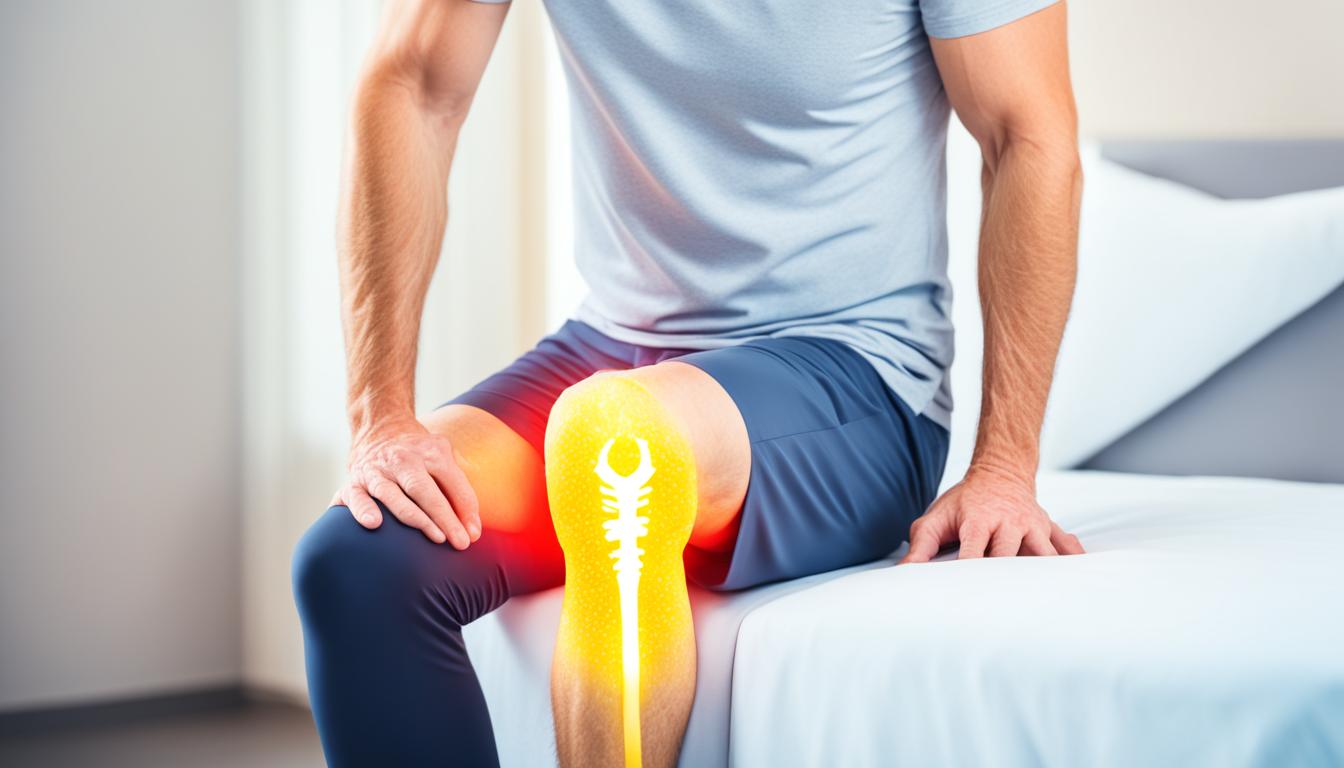Meralgia paresthetica, also known as Bernhardt-Roth or LFCN neuralgia, happens when the LFCN nerve gets damaged. The LFCN typically faces issues at the inguinal ligament. This leads to symptoms in the thigh.
The key symptoms are thigh pain, numbness, burning, aches, and tingling. These issues can greatly affect daily life.
Doctors diagnose it by looking at medical history and doing a physical exam. They must make sure it’s not something else like lumbar radiculopathy. This helps find the right treatment.
If the case is mild, changing habits like losing weight or wearing loose clothes can help. Using cold packs and anti-inflammatory drugs may also reduce pain.
For more serious cases, treatments may involve nerve blocks or surgery. In surgery, the affected nerve is decompressed or removed.
Today, stem cell therapy is showing promise. It’s a new way to treat Meralgia paresthetica. It helps regenerate nerves and heal the damaged area.
Key Takeaways:
- Meralgia paresthetica is a condition caused by damage to the lateral femoral cutaneous nerve (LFCN) resulting in thigh pain, numbness, and other symptoms.
- Diagnosis involves a medical history review and physical examination to differentiate Meralgia paresthetica from other conditions with similar symptoms.
- Treatment options range from conservative management, including identifying causes and pain management, to medical management and surgical intervention in severe cases.
- Stem cell therapy is an innovative treatment option that shows potential in regenerating damaged nerves and promoting healing in Meralgia paresthetica.
- Further research is needed to fully understand and optimize stem cell therapy for this condition.
Causes and Diagnosis
Meralgia paresthetica is marked by pain and numbness in the thigh. It can stem from multiple causes. Being overweight, which strains the lateral femoral cutaneous nerve (LFCN), and wearing tight clothes can also compress the nerve. Diabetes and alcoholism are known to increase the risk of developing this condition. Additionally, surgery on the hip or spine may cause nerve entrapment, leading to Meralgia paresthetica.
To diagnose Meralgia paresthetica, doctors look at a patient’s symptoms and medical history. A physical exam is crucial. They might also perform tests like nerve conduction studies on the LFCN to confirm the diagnosis. It’s important to distinguish Meralgia paresthetica from other similar conditions. This helps in spotting issues like tumors or herniated discs early for the right treatment.
Primary Causes of Meralgia paresthetica
| Causes | Description |
|---|---|
| Obesity | Extra weight can press on the LFCN, causing it to be compressed. |
| Tight Clothing | Wearing very tight clothes might compress the LFCN too, leading to symptoms. |
| Diabetes Mellitus | Diabetes-related metabolic issues can damage nerves, contributing to Meralgia paresthetica. |
| Alcoholism | Abusing alcohol can create metabolic imbalances harmful to nerves. |
| Hip or Spine Surgery | Surgeries in the hip or back area sometimes result in LFCN entrapment. |
Treatment Options
The way Meralgia paresthetica is treated depends on how bad the symptoms are. Nowadays, managing the condition without surgery is often the first choice. Doctors look into what’s causing the nerve problem. They might suggest losing weight or wearing looser clothes to ease the pressure. Also, using cold packs and taking certain medicines can help with pain and swelling.
If the usual treatments don’t work, surgery might be the next step. Surgery can help by either releasing the trapped nerve or removing part of it. This relieves the pressure and lets the nerve work normally again. But, surgery is only done in more serious cases where the nerve damage is bad.
There’s also a newer approach using stem cells. Stem cell therapy aims to repair the damaged nerves and help heal the area. This treatment is still being studied, but it looks promising for improving nerve function and reducing symptoms. Yet, we still need more studies to see how well it really works in the long run.
FAQ
Q: What is Meralgia paresthetica?
A: Meralgia paresthetica is also known as Bernhardt-Roth or LFCN neuralgia. It happens when the lateral femoral cutaneous nerve (LFCN) gets damaged.
Q: What are the symptoms of Meralgia paresthetica?
A: Symptoms include pain, numbness, and burning in the thigh. You might also feel muscle aches and tingling in its front and side parts.
Q: What are the causes of Meralgia paresthetica?
A: This can be caused by factors like being obese or wearing tight clothes. Metabolic issues such as diabetes and alcoholism can also play a role. Even surgeries on the hip or spine could trigger it.
Q: How is Meralgia paresthetica diagnosed?
A: Doctors usually diagnose this from your symptoms and some tests. They might check how your nerve functions to be sure.
Q: What are the treatment options for Meralgia paresthetica?
A: First, they try things like losing weight and using cold packs for the pain. If these methods don’t work, doctors might use nerve blocks or give you pain meds. Stem cell therapy is also an option, but more study is needed to know if it works well.
Q: What is stem cell therapy for Meralgia paresthetica?
A: Stem cell therapy uses special cells to help nerves heal. It’s new and still being researched. But, it could be a good way to treat Meralgia paresthetica in the future.

